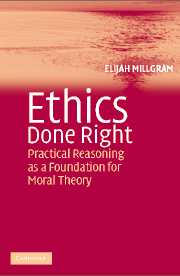Book contents
- Frontmatter
- Contents
- Acknowledgments
- Miscellaneous Frontmatter
- Introduction: The Method of Practical Reasoning
- 1 What's the Use of Utility?
- 2 Mill's Proof of the Principle of Utility
- 3 Does the Categorical Imperative Give Rise to a Contradiction in the Will?
- 4 Reasonably Virtuous
- 5 Murdoch, Practical Reasoning, and Particularism
- 6 Was Hume a Humean?
- 7 Hume on “Is” and “Ought”
- 8 Hume, Political Noncognitivism, and the History of England
- 9 Incommensurability and Practical Reasoning
- 10 Commensurability in Perspective
- 11 Varieties of Practical Reasoning and Varieties of Moral Theory
- References
- Index
10 - Commensurability in Perspective
Published online by Cambridge University Press: 12 November 2009
- Frontmatter
- Contents
- Acknowledgments
- Miscellaneous Frontmatter
- Introduction: The Method of Practical Reasoning
- 1 What's the Use of Utility?
- 2 Mill's Proof of the Principle of Utility
- 3 Does the Categorical Imperative Give Rise to a Contradiction in the Will?
- 4 Reasonably Virtuous
- 5 Murdoch, Practical Reasoning, and Particularism
- 6 Was Hume a Humean?
- 7 Hume on “Is” and “Ought”
- 8 Hume, Political Noncognitivism, and the History of England
- 9 Incommensurability and Practical Reasoning
- 10 Commensurability in Perspective
- 11 Varieties of Practical Reasoning and Varieties of Moral Theory
- References
- Index
Summary
Complete commensurability of ends is a good deal like single-point perspective. When a picture is rendered in perspective, there is a definite answer to the question: of two objects in the picture, which is larger? The answer, in fact, can be made numerically precise; with the perspective grid in place, it is possible to say not only which of the two is larger, but how many times larger it is. Likewise, in a rendering of our practical world that insists on complete commensurability (such as that of Benthamite utilitarians), there is always a fact of the matter as to which of two states of affairs is more important, and that fact allows of numerical precision. There is an answer to the question, “How much more important is this than that?”
“Incommensurability” is a word with different meanings in different areas of philosophy; here, to say that two ends are incommensurable is to say that it is not true that one is more important than the other, and also that it is not true that they are as important (or even roughly as important) as one another. To say that ends are commensurable is usually to say somewhat more than that gloss on “incommensurable” would indicate; it is to imply that they can be, not just compared, but compared using a single measure, and that the comparisons are (something like) quantitative.
- Type
- Chapter
- Information
- Ethics Done RightPractical Reasoning as a Foundation for Moral Theory, pp. 295 - 311Publisher: Cambridge University PressPrint publication year: 2005



